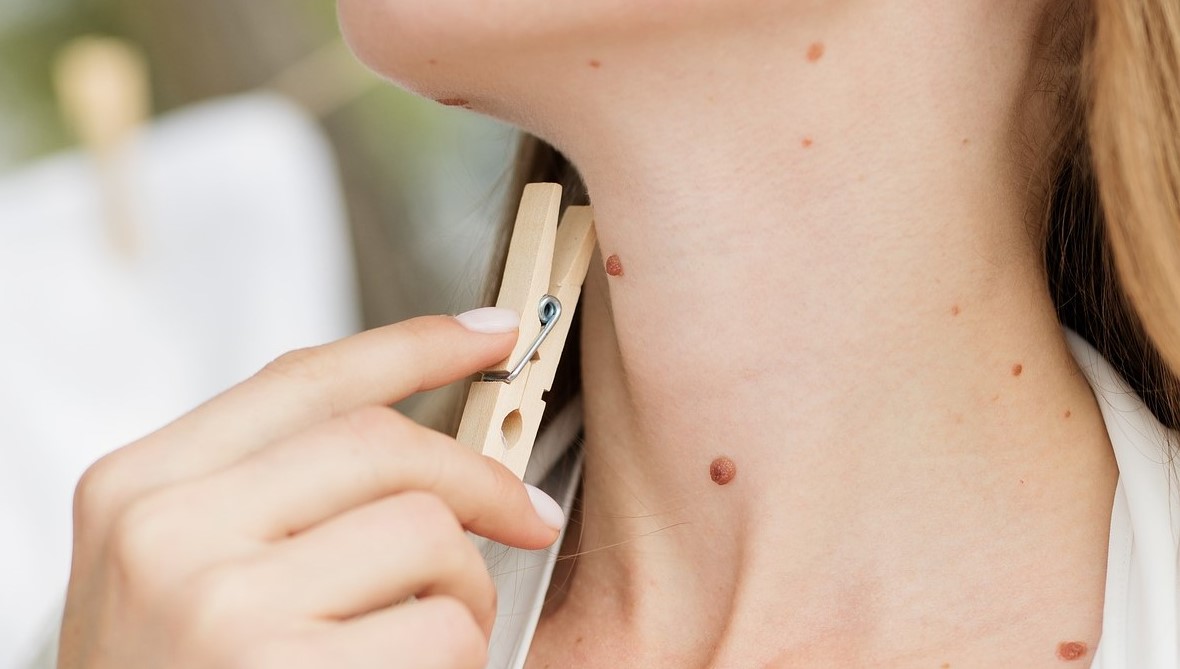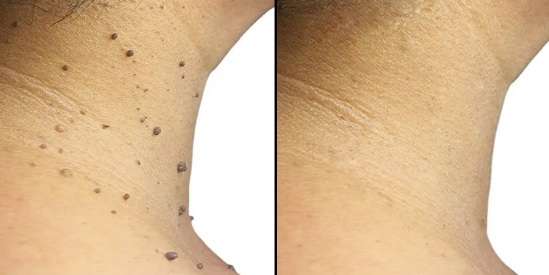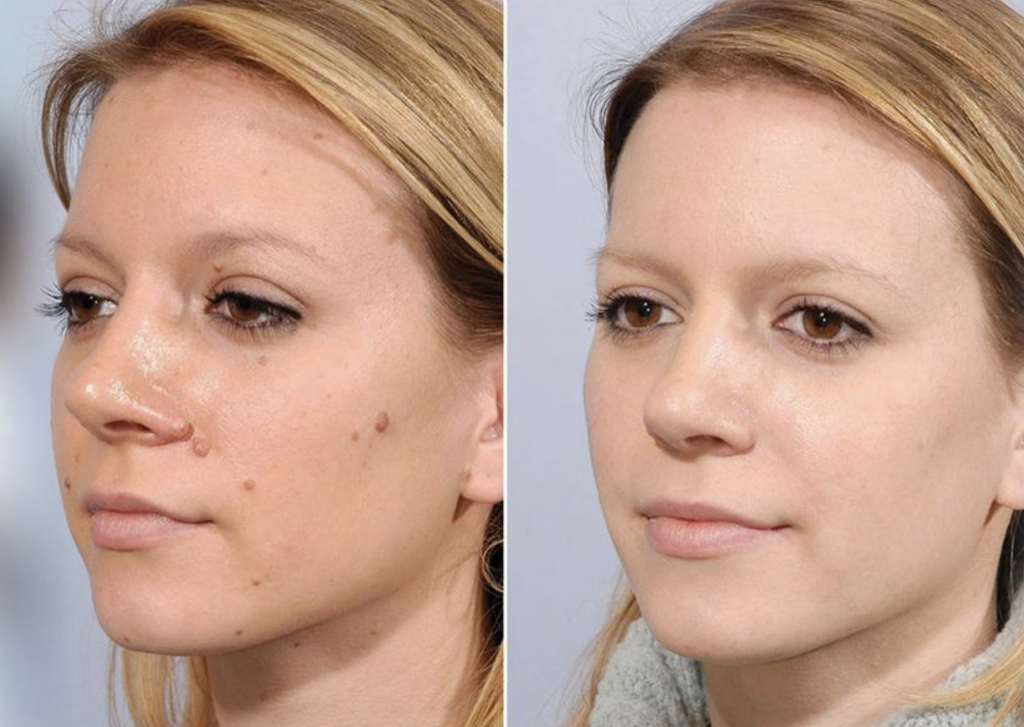

Skin tags are small, benign growths of skin that often appear as tiny, soft, hanging flaps. They are typically flesh-colored or slightly darker and can vary in size. Skin tags are commonly found in areas where skin rubs against skin or clothing, such as the neck, armpits, groin, and under the breasts. While generally harmless, they may be removed for cosmetic reasons or if they cause irritation. Removal methods include cutting, freezing, or using over-the-counter solutions. Consultation with a healthcare professional is recommended before attempting any removal to ensure safety and effectiveness.
Skin tags, also known as acrochordons, typically appear as small, soft growths of skin. They have a narrow stalk, or peduncle, that connects them to the surface of the skin.
Skin tags can vary in size, ranging from a few millimeters to a few centimeters. They often have a flesh-colored appearance, but they can also be slightly darker than the surrounding skin.
Skin tags are more common in areas where the skin experiences friction, such as the neck, underarms, groin, and beneath the breasts. While the exact cause is not always clear, factors like genetics, age, and obesity may contribute to their development.

The exact causes of skin tags are not fully understood, but several factors may contribute to their development. Some potential causes include:
Skin tags are more likely to occur in areas where skin rubs against skin or clothing, leading to friction.
There may be a genetic predisposition to developing skin tags, as they often run in families.
Changes in hormone levels, such as during pregnancy or in individuals with hormonal imbalances, may influence the development of skin tags.
Being overweight or obese is associated with an increased likelihood of developing skin tags.
Skin tags become more common with age, and they are often found in middle-aged or older individuals.
Some studies suggest a possible link between insulin resistance and the presence of skin tags.
While skin tags are typically harmless, there are certain situations where it's advisable to consult a doctor:
Change in Appearance: If a skin tag changes color, size, shape, or becomes painful, it should be examined by a healthcare professional.
Bleeding or Irritation: If a skin tag becomes irritated, red, or starts bleeding, seek medical attention.
Multiple New Skin Tags: The sudden appearance of numerous skin tags may warrant a doctor's evaluation.
Uncertainty about Diagnosis: If unsure whether a growth is a skin tag or another skin condition, consult a doctor for an accurate diagnosis.
Location: Skin tags in sensitive areas like the eyelids, genital area, or areas prone to friction may require professional removal.
Discomfort or Pain: Skin tags are usually painless, but if there is discomfort or pain, especially during removal attempts, consult a healthcare provider.
Ablative radiofrequency (RF) is a medical procedure that eliminates skin tags by utilizing radio waves to heat the targeted area. A specialized tool applies high-frequency energy to the skin tag, inducing heating and eventual melting or burning. This procedure ensures the routine removal of skin tags with minimal discomfort and the likelihood of scars.
The removal of skin tags using ablative radiofrequency is generally deemed safe and effective, but not everyone may be suitable candidates. It is essential to consult with a doctor before determining if this procedure is appropriate for you.
The most suitable approach for your case might be influenced by factors such as the size, location, and number of skin tags. Additionally, various methods like excision, freezing, and cauterization are available for skin tag removal. Consultation with your doctor can help determine the optimal strategy for your specific needs.
The excision of skin tags entails surgically removing the base of the skin tag by a dermatologist, cosmetic surgeon, or skilled professional using sterile medical instruments such as scalpel or scissors. Local anesthesia is commonly administered to numb the area, minimizing pain during the procedure.
Post skin tag removal, the area may be covered with a sterile dressing or adhesive bandage. Mild soreness, redness, and swelling might occur initially, but these side effects typically subside within a few days after the procedure.
Skin tag removal is generally regarded as a safe and effective procedure, carrying a low risk of complications. Every medical procedure carries risks, such as bleeding, infection, or scarring. It's essential to discuss the potential risks and benefits of skin tag removal with a licensed dermatologist before undergoing any operation.
Skin tag removal aftercare involves a few key steps to ensure proper healing and minimize the risk of complications:
Keep the Area Clean: Gently clean the treated area with mild soap and water. Avoid harsh chemicals or irritants.
Apply an Antiseptic: Use an antiseptic ointment or cream to prevent infection. Follow your healthcare provider's recommendations.
Avoid Scratching or Rubbing: Resist the urge to scratch or rub the treated area, as this could irritate the healing skin.
Avoid Tight Clothing: Wear loose-fitting clothing to prevent friction and irritation on the treated area.
Use Sunscreen: Apply sunscreen to the treated area if it's exposed to sunlight. This helps prevent pigmentation changes.
Monitor for Signs of Infection: Watch for signs of infection, such as increased redness, swelling, or discharge. If noted, consult your healthcare provider.

To remove skin tags, consider tying them off with dental floss, using over-the-counter solutions, freezing with liquid nitrogen, or seeking professional methods like laser therapy or surgical excision. Always prioritize hygiene and seek expert guidance for safety.
Skin tags can be removed using various techniques, including tying them off, over-the-counter solutions, freezing with liquid nitrogen, or professional methods like laser therapy or surgical excision. Prioritize hygiene and seek expert guidance for safe removal.
Home remedies for skin tags removal include tying them off with dental floss, applying apple cider vinegar, or using tea tree oil. These methods may take time and caution, and consulting a healthcare professional is advisable for safe removal.
Using toothpaste for skin tag removal is not recommended. While some may claim its efficacy, there's no scientific evidence supporting this method. Consult a healthcare professional for safe removal options.
Self-removing skin tags may pose risks of infection, bleeding, or scarring. Consultation with a healthcare professional is advisable for safe and effective removal methods tailored to individual needs.
Copyright @ VCUS Healthcare Center. All Rights Reserved | Designed By Channel Softech